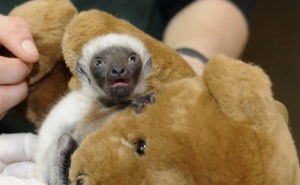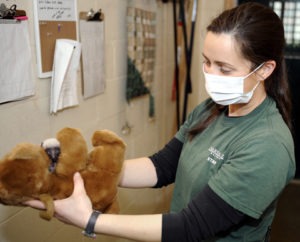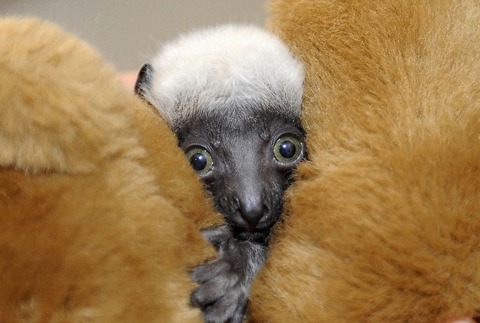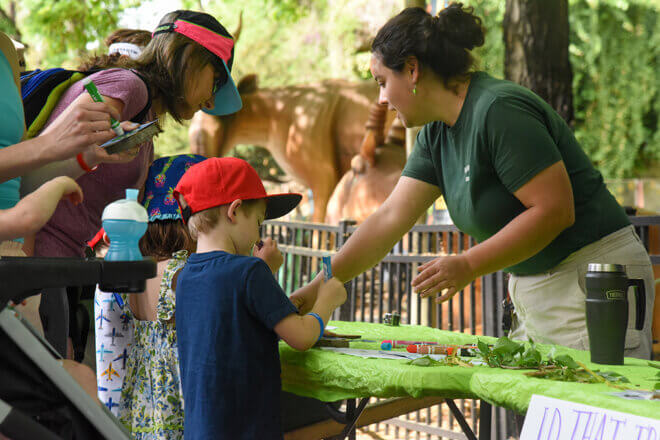BALTIMORE, MD — The Maryland Zoo in Baltimore is pleased to announce the birth of a male Coquerel’s sifaka (CAHK-ker-rells she-FAHK) baby born on Saturday, March 30, 2013. “We are excited by this new birth, and our continuing contribution to the Coquerel’s sifaka population,” stated Mike McClure, general curator. “The staff is happy to note that the baby is healthy, and to observe that the baby and his parents have been bonding quite nicely in a quiet off exhibit area since the birth.”

The Maryland Zoo’s sifaka pair, Anastasia, age 9, and Gratian, age 11, are also the parents of two-year-old Otto and 15-month-old Nero, both born in 2011 at the Zoo. Infant Maximilian’s, (Max) weight on the day after his birth was 101 grams, which falls in the average birth weight range of 85-115 grams. “At his second vet check he had gained 8 grams, bringing him to 109 grams, which shows us he is nursing and thriving,” said Carey Ricciardone, mammal collection and conservation manager at the Zoo. “Ana is a proven mother, however we always ere on the side of caution by keeping a close eye on Mom and baby off exhibit, giving them time to bond and for us to observe his growth.”
Sifaka are born with sparse hair and resemble tiny gremlins. In time, white hair soon grows in and they begin to resemble their parents. Newborn sifaka ride on their mother’s belly for the first month, then graduate to riding on her back. “We expect to start seeing the infant crawling around on mom’s back a little more in the next couple of weeks,” continued Ricciardone. “By the end of April, he will begin to sample solid food and crawl on Ana’s back periodically and he should begin to venture a few feet away from her by six to eight weeks of age.” Gratian does take a little interest in the baby, although sifaka fathers do not closely assist with the childrearing.

Coquerel’s sifaka (Propithecus coquereli) are lemurs; native only to the island of Madagascar off the southeastern coast of Africa. Coquerel’s sifaka spend most of their lives in the treetops in two protected areas in the sparse dry, deciduous forests on the northwestern side of the island. As with many species of lemur, Coquerel’s sifaka are endangered — habitat loss due to deforestation is the leading threat to sifaka, as is the case with many species of lemur. Sifaka have a unique brown and white coloration and are distinguished from other lemurs by the way that they move. They maintain a very upright posture and, using only their back legs, leap through the treetops. They can easily leap more than 20 feet in a single bound. On the ground, they spring sideways off their back feet to cover distance.
Max’s birth is the result of a recommendation from the Sifaka Species Survival Plan (SSP) coordinated by the Association of Zoos and Aquariums (AZA). SSPs provide breeding recommendations to maximize genetic diversity, with the goal of ensuring the long-term survival of the captive population and the health of individual animals. There are only eight accredited zoos that house the 50 Coquerel’s sifaka in the U.S. and this tiny baby represents 2% of the total captive population in the country.
Zoo visitors can now to see Ana, Gratian and Max in the sifaka exhibit inside the Chimpanzee Forest. “We will be alternating the sifaka that are on exhibit — some days Otto and Nero will be out and other days it will be Ana, Gratian and the new baby,” concluded Ricciardone. “We have a new outdoor sifaka habitat under construction, so this summer we will move one of the groups outside, while the other will remain in the Chimpanzee Forest.”






Share this article